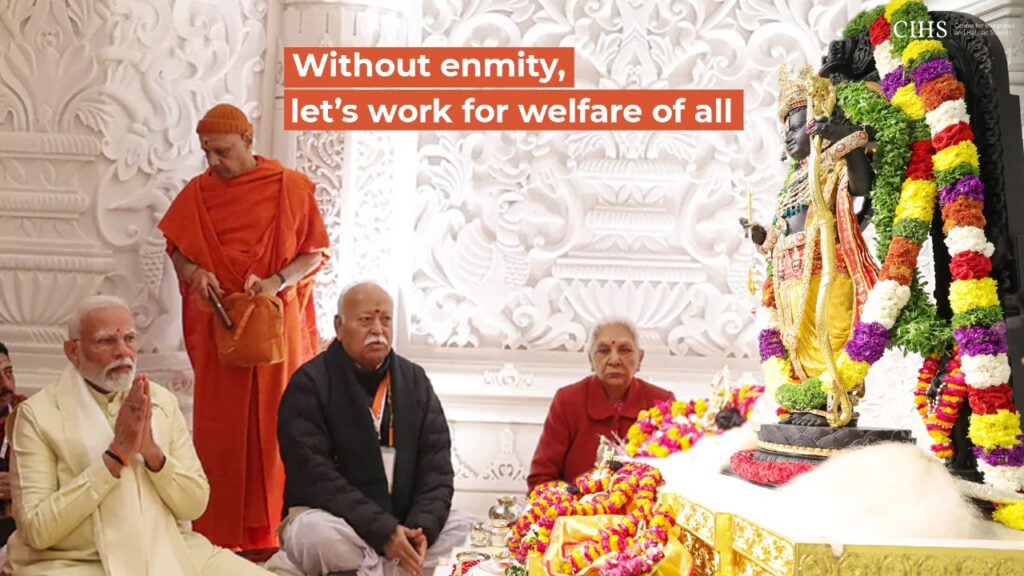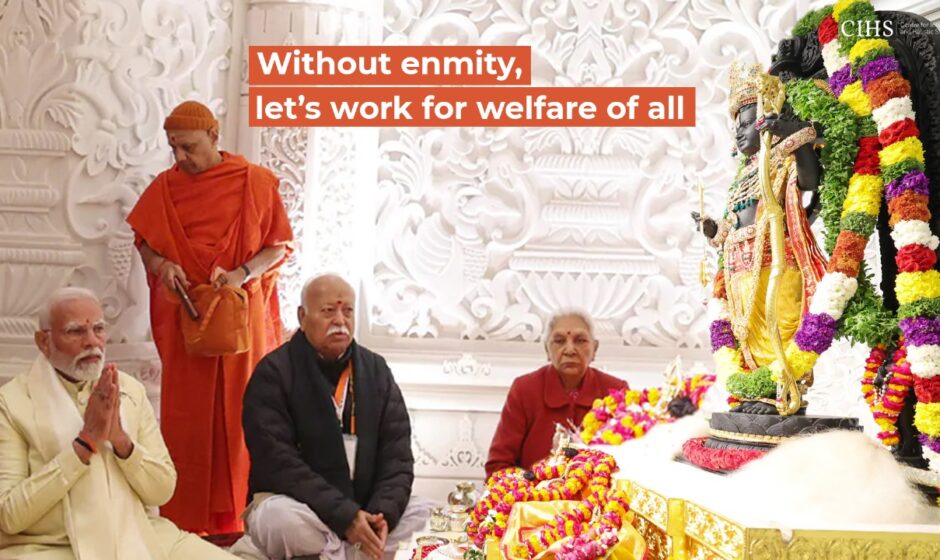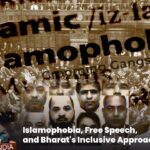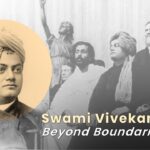Taking inspiration from Bhagwan Ram, let’s pursue path of harmony, unity, progress and peace; reconstruction of Bharat and entire world.
Dr Mohan Bhagwat
The history of our Bharat is one of continuous struggle against invaders for around last one and a half thousand years.

The aim of early invasions was to plunder and sometimes (like Alexander’s invasion) was for colonisation. But, attacks from West in the name of Islam only brought complete destruction and alienation of the society.
To demoralise the nation, society, it was necessary to destroy their religious places, hence foreign invaders destroyed temples in India. They did this not once but multiple times. Their aim was to demoralise Bharatiya society so that they could rule over Bharat unhindered with a weakened society.
The demolition of Shri Ram temple in Ayodhya was also done with same intention and for same purpose. This policy of invaders was not limited to just Ayodhya or any one temple, but was a war strategy for the entire world.
Indian rulers never attacked anyone, but invaders of the world have done such misdeeds by being aggressive for expansion of their kingdom. But in Bharat, it did not have the desired results, not at least as per their expectations. On the contrary, in Bharat, the faith, commitment and morale of the society never diminished, the society did not bow down, their struggle of resistance continued.
Therefore, repeated attempts were made to take control of Shri Ram’s birthplace and build a temple there. There were many wars, struggles and sacrifices for him. And, the issue of Ram Janmabhoomi ingrained in the minds of Hindus.
In 1857, when war plans started being made against the foreign i.e. British rule, Hindus and Muslims together expressed their readiness to fight against them and then there was a mutual exchange of ideas between them.
And, at that time, a situation evolved where there would be a reconciliation on issue of banning cow slaughter and liberation of Shri Ram Janmabhoomi . Bahadur Shah Zafar also guaranteed a ban on cow slaughter. As a result, entire society fought together. Bharatiya people showed bravery in that war but unfortunately this war of Independence failed. Then, Bharat did not get independence, British rule remained uninterrupted, but the struggle for Ram Temple did not stop.
According to British policy of “Divide and Rule” towards Hindu-Muslims which was already in practice, gained even more prominence after 1857. To break the unity, British hanged the heroes of the struggle in Ayodhya and question of liberation of Ram Janmabhoomi remained unresolved. The struggle for Ram temple continued.
After Independence in 1947, when Somnath temple was unanimously renovated, the discussion about such temples started. Similar consensus could have been considered regarding liberation of Ram Janmabhoomi, but the direction of politics changed. The selfish forms of politics such as discrimination and appeasement became prevalent and hence the question remained as it is.
On this issue, governments did not even consider the wishes and sentiments of Hindu society. On the contrary, they tried to destroy initiative taken by the society. The legal battle related to this, which had been going on since pre-independence, continuously carried on. The mass movement for the liberation of Ram Janmabhoomi began in the 1980s and continued for thirty years.
In 1949, the Murty of Bhagwan Shri Ramchandra appeared at the Ram Janmabhoomi. In 1986, the mandir was unlocked as per court order. In the coming period, the continuous struggle of Hindu society continued through many campaigns and kar seva. In 2010, a clear judgement of Allahabad High Court clearly came before the society.
The efforts had to be sustained for final resolution of the issue at the earliest. On November 9, 2019, after 134 years of legal struggle, the Supreme Court gave a balanced decision after examining the truth and facts. The feelings and facts of both parties were also considered in this decision. This decision has been given after hearing the arguments of all parties in the court.
According to this decision, a board of trustees was constituted for constructing the temple. Bhoomi pujan of the temple took place on August 5, 2020 and now, Paush Shukla Dwadashi Yugabd 5125, accordingly on January 22, 2024, installation and Pran Pratishtha ceremony of the Murty of Shri Ramlala has been organised.
From Dharmic point of view, Shri Ram is the most worshipped deity of majority society and the life of Shri Ramchandra is still accepted as an ideal code of conduct by entire society. Hence, now the conflict that has arisen as for and against over the dispute should be ended.
The bitterness that has arisen in the meantime should also end. Enlightened people of the society must see that the dispute ends completely. Ayodhya means a city ‘where there is no war ‘, ‘a place free from conflict’. On this occasion, in the entire country, reconstruction of Ayodhya in our mind is the need of the hour and also the duty of all of us.
The occasion of construction of Shri Ram mandir in Ayodhya marks reawakening of national pride. This also signifies acceptance of the vision of life behind the character of Shri Ram by modern Bharatiya society.
Lord Shri Ram is to be worshiped in the temple with rituals of ‘Patram, Pushpam, Phalam, Toyam’ (leaves, flowers, fruits and water) and at the same time, by establishing image of Shri Ram in our minds, in the light of the same inculcating ideal conduct, we have to worship Shri Ram. As “Shivo Bhootva Shivam Bhajet, Ramo Bhootva Ramam Bhajet” (to worship Shiva, Be Shiva, to worship Ram, be Ram) is called true worship.
If we consider from this point of view, then according to the social nature of Bharatiya culture, we need to imbibe “Matravat Pardareshu , Pardravyeshu Loshtvat. Atmavat sarvabhuteshu , yah pasyati sah panditah” (He is a wise man who sees the wives of others as his mother, the wealth of others like clod of earth and all beings as his own self). In this way, we too will have to follow the path of Shri Ram.
Integrity in life, forgiveness with strength and bravery, sincerity and humility, compassion and care in dealing with everyone, gentleness of heart and strictness towards oneself in performing the duty etc., these are the qualities of Shri Ram that everyone should emulate in their life and in their family. Efforts to bring it into everyone’s life will have to be made with honesty, dedication and hard work.
Besides, keeping in view our national life, discipline will have to be instilled in social life also. We know that on the basis of same discipline, Shri Ram-Lakshman had completed their 14 years of exile and successful completed the fight against the powerful Ravana. To once again spread qualities of justice and compassion, equality with social harmony, fairness and social virtues reflected in the character of Shri Ram; to once again build a pursuant and courageous society based on equal justice without exploitation, endowed with strength as well as compassion. This would be social worship of Shri Ram.
This world is on destructive frenzy due to egoism, selfishness and discrimination and is bringing infinite calamities upon itself. The entry of Shri Ramlala in Ram Janmabhoomi and his Pran Pratishtha is beginning of the campaign for reconstruction of Bharatvarsh which is for the well-being of all, accepting all without enmity and showing the path of harmony, unity, progress and peace.
We are active followers and implementers of that campaign. In the devotional celebration of January 22 along with reconstruction of the temple, all of us have resolved for reconstruction of Bharat and through it paving the way for reconstruction of the entire world. By always keeping this guiding light in mind, moving forward is the need of the hour.
Jay Siya Ram!
(Author is Sarsanghchalak of Rashtriya Swayamsevak Sangh, Nagpur, Bharat. This article was first published on January 21, 2024 commemorating Sh Ram Lalla’s pranprathista at Ayodhya)



